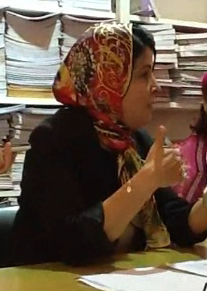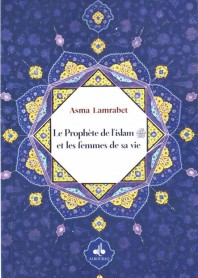What does the Qur’an say about the interfaith marriage?

Asma Lamrabet
18-01-2013
It goes without saying that the marriage of a Muslim woman to a non-Muslim man is one of the main taboo issues in debates on Islam.
According to a broad consensus religiously sterile, a Muslim woman is formally forbidden to marry a non-Muslim man regardless of his religion, while a Muslim man is allowed to get married to a non Muslim woman, mainly a Christian or a Jew, considered by the Islamic schools as “People of the Book”[1].
What does the Qur’an say about this issue and how does it deal with the marriage of Muslim men and women to non-Muslims?
In the Qur’an, there is only one verse that clearly tackles this issue. It is absolutely the main verse that states a provision on marriage with a category of non-Muslims.
Allah says: “Do not marry idolatresses (al mushrikāt) till they believe; and certainly a believing maid is better than an idolatress even though she would please you; and do not marry idolaters (al Mushrikīn) till they believe (hata yūminū), and certainly a believing slave is better than an idolater, even though he would please you. These invite to the Fire, and Allah invites to the Garden and to forgiveness by His grace, and makes clear His revelations to mankind so that they may remember.”Qur’an 2:221.
Through this Qur’anic order, the verse clearly forbids the marriage of the believing men and women to polytheists, called at the time “mushrikīn”.
We should be aware of the fact that this order made sense because it was revealed at the time when polytheists (al-mushrikīn) were engaged in a merciless war against the believing Muslims. It is also worth reminding that polytheists were belonging to an aristocratic class of obscene wealth and indecent conduct, and whose lifestyle was reconsidered by the new social values of fairness and equity of Islam.
While the Qur’an acknowledges the possibility of a mutual attraction between a believer, man or woman, and a polytheist, it strongly recommends against such alliance. The verse seems to urge Muslim men and women to choose the modest believing slaves over the rich arrogant polytheists even if the latter would look more attractive than the poor slaves.
This allusion to “slaves” (men and women) is quite indicative of the moral values that the Qur’anic Revelation tended to inculcate in people. On the one hand, the Qur’an showed “Tolerance” towards the fact of slavery that was universally common at the time; on the other hand, it sought to break the first chains of social hierarchy by preferring these “poor” believing slaves to those wealthy people who formed the elite then.
By getting married to slaves regardless of their social hardship, Islam encouraged Muslims to value people on other basis than their social class, and henceforth; find a balance between the differences established by the ethnic-tribal system at that time.
Furthermore, the new believers needed to be protected from polytheists’ abuse who considered this new religion of Islam as a threat to their own interests. The Qur’an urges Muslim men and women to get married to believers who had, like them, such faith awareness and were conscious of justice on earth. The purpose was to absolutely avoid the marriage of Muslims to polytheists who made every effort to stand against a religion that was defending the most vulnerable people on earth.
Muslim men and women were, therefore, encouraged to get married to those who believe, like them, in one God symbolizing a monotheism purified from all other divinities and injustice.
Thus, the said verse stipulates that Muslim men and women are allowed to contract marriage with believers (mu’minīn) and prohibited to marry polytheists (mushrikīn). It is worth mentioning that the the Qur’anic verse clearly stresses the totally egalitarian approach in favor of both men and women and which is not confusing at all. The Qur’anic order is addressed to both men and women on an equal footing.
Nevertheless, the concept of the believing man and woman to whom Muslim men and women are allowed to get married is still a matter of debate and is not clearly defined in the Qur’anic verse.
What kinds of “believers” are referred to? Does it refer only to people who have just embraced Islam? Or does it imply the act of believing in its broad meaning, believing in One God and a monotheistic Revelation, which includes obviously believers of other monotheistic religions?
Obviously, the said verse is open to interpretation. However, irrespective of any interpretation, it is clear that this Qur’anic order applies to Muslim men and women equally. Yet, none of the different Islamic exegeses allude to this.
In fact, by perusing the different classical interpretations, you get astonished to discover that this concept of the “believing men and women” is unanimously perceived differently depending on whether we refer to Muslim men or Muslim women.
Besides, all of the classical interpretations focused on the first part of the verse which is addressed to Muslim men. And the different debates shed light on the concepts of the “believing woman” and “polytheist woman” whom a Muslim man is legally allowed to marry[2].
The exegete Ibn Kathir begins his interpretation of the said verse by defining “polytheists” as people who worship idols (‘abadatu al assnām)[3].
Most of the classical and contemporary exegetes carried out an in-depth analysis of the first part of this verse addressed to Muslim men, while they gave less importance to the second part that concerns Muslim women on the same issue.
The commentators, henceforth, stipulate that Muslim men are allowed to marry women belonging to “People of the Book” (ahl al kitāb), i.e. Christian or Jewish women who are considered by the majority of the same commentators as believers. Most of the exegetes defend their opinion by referring to another verse that legitimates the first verse and proves that Muslim men are allowed to marry Christian or Jewish women who are not included in the concept of disbelief or Kufr[4] as stated by other scholars.
Indeed, this Qur’anic verse that many commentators allude to says: “As to marriage, you are allowed to marry the chaste from among the believing women and the chaste from among those who have been given the Book before you (are lawful for you); provided that you have given them their dowries, and live with them in honor, not in fornication, nor taking them as secret concubines.”Qur’an (5:5).
For the majority of the exegetes, this verse closed the debate on “the disbelief” of Christians or Jews concluding that they are neither disbelievers nor polytheists (Mushrikīn).
As to the exegete Ibn Achour, he went further in his interpretation by assuming that the verse absolutely prohibits the marriage of Muslim men or women to polytheists (al mushrikīn) while people belonging to other monotheistic religions are not explicitly mentioned. He added that the concept of polytheist is not clearly defined though he agrees with other scholars in giving authorization to Muslim men to marry Christian and Jewish women[5].
For the second part of the said verse that seems to be addressed to both Muslim men and women and to grant both of them the same authorization, we can affirm that Muslim scholars and jurists unanimously agree on the fact that marriage of a Muslim woman to a non-Muslim man, whether he is polytheist, Christian or Jew, is strongly prohibited.
Ibn Achour assumed the inexistence of a religious text that allows or forbids the marriage of Muslim women to Christian or Jewish men. He added that scholars agreed to forbid such marriage for several reasons related to the analogy (al quiyāss) and consensus (Ijmā’), while they confess that there exist no specific reasons of this prohibition in the religious texts[6]. As far as this scholar is concerned, forbidding the marriage of a Muslim woman to a Christian or a Jewish man is not based on any Qur’anic text or saying of the Prophet, but rather on a mutual agreement of scholars of all eras[7].
The majority of scholars do not give enough explanation as to this prohibition that seems to contradict the general meaning of gender equality implied in this Qur’anic verse.
Yet, other commentators tried to justify this prohibition by providing another verse that assumes the following: “O you who believe! When believing women come to you as fugitives (Muhājirāt), examine them (famtahinūhuna). Allah is best aware of their faith. Then, if you find them to be believing women, do not send them back to the disbelievers (kuffār). They are not lawful for them (the disbelievers), nor are they (the disbelievers) lawful for them.” Qur’an 60:10.
The revelation context and the general meaning of this verse are not, however, associated with the case of marriage to non-Muslims. The classical interpretation states that this verse was actually revealed when two polytheist men from Quraish asked for their sisters to be back, Oum Kelthoum and Bint Aqabah, after they had converted to Islam and migrated to Medina in order to join the Muslim community[8].
It is worth reminding that the Prophet signed at that time an agreement called Al-Hudaybya Treaty with the opposing tribe of Quraish to stop the war for ten years. This agreement stipulated, among others, that any Quraychit woman who would join the Prophet in Medina without the permission of her legal tutor should be sent back to Mecca.
Oum Kelthoum, who was the only one to convert to Islam in her family, and who escaped from one of the most hostile environments, begged the Prophet not to repatriate her to her tribe so as not to be exposed once more to their unfair treatment[9].
The verse above mentioned was then revealed to prevent the extradition of women who converted to Islam and avoid the vengeance of their respective families. For this reason, the Prophet refused to send back the exiled women to the enemies, while the agreement was maintained for men.
The explanation of the verse above mentioned shows that it does not tackle in any way the marriage to non-Muslims, but was rather revealed to meet some strategic requirements of protecting women who converted to Islam against the will of their family and who voluntarily asked for the Prophet’s protection.
The contradiction that we highlight in these classical interpretations concerns the fact that according to these scholars, Muslim women are not allowed to marry “disbelievers” including Christian and Jewish men, while for the case of Muslim men, Christian and Jewish women are considered as believers. How can we consider, in the same Christian or Jewish community, that men are disbelievers while women of the same communities are believers?
In the absence of any proof that justifies the prohibition of the marriage of Muslim women to the followers of other monotheistic religions, the contemporary scholars justify their attitudes by “the natural weakness” of Muslim women who may go astray under the “bad” influence of their Christian or Jewish husbands. They added that it will adversely affect the children’s education. But the Muslim man is able to dominate his Christian or Jewish wife and protect his children’s and own faith. This generalized idea is not always true and the “strength” or the “weakness” of the religious belief is not associated with the gender but rather with the person’s personality and character.
In fact, the argument is not convincing because if the said verse forbids the marriage between a Muslim woman and a Christian or Jewish man as it is unanimously interpreted today, so such marriage is also forbidden for the Muslim man. Nevertheless, according to various Qur’anic verses and the Islamic ethics, Christians and Jews are considered unanimously as believers belonging to religions revealed by Allah regardless of the existing differences in terms of the dogma and the theological philosophy.
As a result, the analysis of this verse shows that the Qur’an prohibits the marriage of both Muslim men and women to polytheists.
The Qur’anic verse, tackling the marriage of Muslim men or women to believers of other religions, set some rules using an egalitarian language. But it is worth mentioning that scholars agree unanimously on the prohibition of the marriage of a Muslim woman to a Jewish or Christian, while no part of the Qur’an provides for such prohibition that justifies this discrimination.
The question raised in this regard is how can we today, in the current conceptual, cultural and globalized situation, categorize people according to their faith, religious or cultural backgrounds? How can we recognize a person to be Muslim, believer, Christian, Jew or polytheist? What can we say about those people who do belong to a religious culture, many of whom are Muslims, yet still admit to be atheist or agnostic?
What can we say about people from the same Muslim culture who are married together but who, religiously speaking, inherit no more than the family name and some cultural customs? While a non-Muslim man who wants to get married to a Muslim woman should often prove his Islam “in appearance” in order to “save his face”, while the rest is just lies and outward show.
It is true that marriages called “mixed” can be more exposed to misunderstanding due to the cultural or religious differences that may, at any moment, lead to marriage instability. However, this concerns all marriages, but the most important is to have a common interest at the intellectual and spiritual levels strengthened mainly by mutual respect.
Despite all the differences and the problems that may arise during a marital life, it is fundamentally the mutual respect which will spread shared serenity and the harmony of love whose strength lies once again in the respect that one shows to the other’s beliefs and traditions.
This article is not meant to encourage young Muslim women, who wisely would like to preserve their family spiritual inheritance, to disregard traditions, but rather to overcome the taboos and the hypocritical social practices that turn out to be sometimes unfair.
It is high time to have the intellectual courage to tackle such topics while debating Islam to avoid the moral suffering and the feeling of guilt experienced today by many young Muslims, mainly, those who live in the West and are more likely to meet non-Muslim partners in their personal life.
At the moment of choosing a partner, young Muslim men and women have to do it under their full responsibility with serenity, clarity and wisdom.
Such debate is missing in our contemporary Muslim societies where unfamiliar ideas and the social conformism replaced the intellectual and spiritual honesty. Therefore, we should no more hide behind an unconvincing bastion of identity, but rather face the reality and admit that the world has deeply changed. We should also know that to preserve the spirituality of the heart, it would be necessary to override the hypocrisies and the social duplicity that eroded our current way of life.
We should go back to the meaning, the purposes and the moral of the Qur’anic verse that talks about the interreligious marriage through a dispassionate debate that goes beyond emotions. We should review the real and deep meaning of some concepts in our globalized and multicultural societies such as “the believing men and women” and “People of the Book” … We should stress the main value and the initial spiritual trend that underlie this verse that calls for honesty, decency and the mutual respect as the pillars of any marriage.
Allah is the Best Knower.
[1] « People of the Book » or ahl al-kitāb are people belonging to a religion in which a Book was revealed as the Torah or Bible. Muslims are compelled to believe in these books since they were revealed by the same Creator. The Qur’an, the last revelation, is the follow-up of the same universal spiritual message addressed by God to all humans by means of His successive prophets.
[2] Attabari, Ibn Kathir, Azamakhchari and Arrazi.
[3] Tafssir Ibn Kathir, p 604, Vol 14.
[4] See the interpretation in Tafssir Attabari, p 299, Vol 17 and Tafssir Ibn Kathir.
[5] Tafssir Atahrīr wa tanwīr of Ibn Achour, p. 359, Vol 1-2.
[6] Idem
[7] The very rare hadiths that forbid the marriage of Muslim women to “People of the Book” are considered as weak according to the opinion of the majority of scholars. See Attabari in his interpretation of the verse 2:221. Idem.
[8] Tafssir Ibn Kathir.
[9] Al Fassi « al ‘aql al matīn », in Asmaa Ahmed Zayda’s book, « dawr al mar’a assiyassi fil ‘ahd nabawi wa al khulafa’ arrāshidīn”, Dar Assalam, 2001, p 151.
À propos de l'auteur

ASMA LAMRABET
Native de Rabat (Maroc), Asma Lamrabet, exerce actuellement en tant que médecin biologiste à l’Hôpital Avicennes de Rabat. Elle a exercé durant plusieurs années (de 1995 à 2003) comme médecin bénévole dans des hôpitaux publics d'Espagne et d’Amérique latine, notamment à Santiago du Chili et à Mexico.






